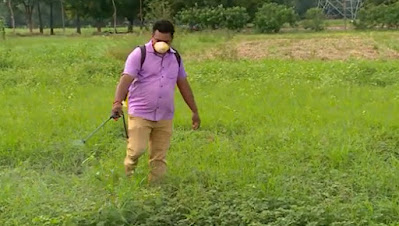General Principles and Approaches in Weed Management!
Weed is an unwanted plant that grows in the wrong place under certain conditions. The word "weeds" is often used to refer to the growth of these undesirable plants in unwanted areas among the crops we cultivate. They interfere with the use of land and water resources and create barriers to the growth of our crops. Due to this, it is necessary to pay more attention to weed control and management.
Why control weeds?
Weeds are one of the most important factors in creating negative effects on crop production and their effects can have a huge impact on agriculture and create more losses. Losses caused by weeds are higher than losses of any kind in production. Weeds account for 45% of total annual losses in agricultural production. With this in mind, weeds should be controlled and better managed. Weeds compete with crops for sunlight, moisture, nutrients, and the need for space. Weeds are so aggressive in competing. Crops may therefore lose all of these resources in competition for optimal yields. Weeds can significantly reduce crop yields by releasing toxins or secreting factors that inhibit crop growth. Weeds act as a habitat for diseases and pests. They increase the cost of production and processing and refining. Severe weed infestation will reduce the quality and value of the product.
Weed control
Weed control measures are all processes to control weed infestation and reduce competition with crops. When weeds are low they produce less effect on crop growth and yield. However, this principle is used when there is a weed problem. This cannot be considered a preventive measure.
Mechanical / body control
In machine weed control, we use farm equipment to control weeds. The most commonly used mechanical control techniques are plowing (including plowing and plowing), mulching, hand removal, burning, and mowing.
Biological weed control
Biological weed control involves the use of natural enemies of weeds to control the germination of weed seeds or the spread of established plants. It is fast becoming a popular method. Examples are Dansy Rockwort or leaf spurge control goats, the Cinnabar moth, and the Dancy Fly beetle to control Dansy Rockwort.
Chemical Weed control
It refers to all techniques that involve the application of a chemical (herbicide) to weeds or soil to control the germination or growth of weed species. Chemical control of weeds is popular among farmers. More can be done with the will. Common examples of chemicals used to control weeds are 2,4-D. Glyphosate, Penta methylene. Fluchlorine,
Integrated Weed Management (IWM)
It is a sustainable, low-cost, long-term weed management approach. It uses a variety of weed management techniques such as cultural, mechanical/physical, biological, and chemical methods. Currently, the herbicide is a powerful tool for weed control. However, there is the issue of its stability. Herbicides are expensive, the continuous use of herbicides builds resistance to weeds, and its environmental impact is increasing.
Basic principles of IWM
Reducing the overall economic impact of weeds. Reducing herbicide use. Providing optimal economic returns on crop yields Improving crop yields and profits. Protecting natural resources and minimizing environmental impacts, In short, the combined use of culture, machinery, biology, and the use of chemicals, etc. to control, control or eradicate weeds can be of great use in management methods.
Weeding and intercropping methods
Weeds should be taken at regular intervals and the pits should be kept clean. The blankets should be removed at the neck of the coconut. Do not fill the pits with soil on the side as soon as the tree has grown. Weeds can be controlled with proper intercropping and the weeds can be used as mulch. Plowing methods can be manipulated to control the weeds in an environmentally friendly manner and to use them as mulch, either by plowing, digging, digging, or composting. The spacing between trees is plowed twice a year in June - July, and December - January. Two plows or The two clusters should be carried out in May-June and September-October respectively. Otherwise, the harassment work will have to be carried out in January.
Water Management:
In weed control, water management plays an important role.
Germination of weed seeds:
Watering a few days before sowing the crop, and germination of weed seeds is a hoop in weed management. The sprouted weeds should be removed and the crop should be planted as soon as possible. This will help to avoid weed infestation due to climate change.
Sowing according to moisture content:
The solution is to remove the weeds and let the soil dry, as stated above. They will be like a blanket of land. When sowing the crop, at the place of sowing, dry soil should be removed and sown in moist soil. Large seed pods such as sorghum and beans can be sown in this way. These germinate and provide shade to the surrounding areas, controlling weed growth.
Four types are weed control.
Weed control People should be used to uproot the weeds one by one, pile them up and let them dry. Next, if the crop is grown in rows in the field, the intermediate weeds can be cut into pieces, piled up, and dried using a 'weeding' machine. Finally, it can be fertilized and fed to the crop. Maintaining Weed Growth When cultivating sunflower, flat legumes, and maize, sunflower is absorbed by the leaves and prevents weeds from growing. Besides, weeds do not grow when hemp and cactus plants are grown and fertilized with soil. In this method, pandal can be used for vegetable cultivation.
'Mulching' technology is a seven micron thick, plastic cover placed in the field through a small hole to prevent weeds from growing when sowing the crop. The technology is used in crops including tomato, cassava, watermelon, aubergine, betel nut, and lily of the valley.
Other links - Nutrition Management in Coconut






.jpg)
.jpg)
.jpg)

.jpg)
.jpg)
.jpg)
.jpg)
0 Comments